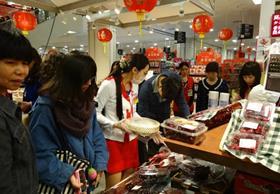
China remains the standout market for Chile’s cherry exports, absorbing close to 90 per cent of the South American export giant’s shipments.
As this season's arrivals into China shifted from air to sea shipments in early December, some importers flagged concerns over weaker pricing and slow demand, however. There have been reports domestic consumption in China is weakening due to a slowing economy, impacting demand for higher-value imported fruits. Some importers reported that market prices of Chilean cherries were already much lower year-on-year in early December, before seafreight volumes had even arrived.
Chile’s cherry exports are expected to rise by more than 15 per cent this season, with the Chilean Cherry Committee forecasting a crop of 210,214 tonnes, equivalent to 42m (5kg) cartons. The first seafreight vessel arrived in China on 5 December and arrivals are expected to continue through mid-February. With Chinese New Year falling earlier in 2020 – on 25 January – there is more pressure on sales, so any sign of deteriorating demand is a worry for the industry.
However, leading industry players have played down reports of a slowdown. Hernan Garcés of Garcés Fruit China told Asiafruit that a sizeable year-on-year increase in airfreight shipments in late November put some pressure on the market. But he added that since the first seafreight vessel arrived, the market has actually been stronger than the corresponding point in 2018/19.
“The market in China is quite tough to read,” said Garcés. “In the middle of the air shipments, from 26 November through 30 November, the market was quite weak but that was only because of a 50 per cent increase in volumes shipped in weeks 48 and 49. So then it took time for the market price to adjust.
“But then right before the first vessel arrived, the market went back to normal, partly because we had the 12/12 e-commerce festival coming and the second vessel was due to arrive by 13/12. Retailers really needed cherries for all the promotions they had in place.
“With an increase of over 25 per cent on volumes by air it’s hard to say we’re suffering a weak market since what we have here is a perfect balance between offer and demand. If we as an industry give Chinese consumers good-quality cherries I am confident we’ll have a good season.”
George Liu of Shanghai-based importer/distributor Frutacloud also reported strong demand and prices for seafreight arrivals of Chilean cherries. “Chilean cherries continue to be sought after this year,” he said. “What’s different this year is that the prices aren’t going down. Usually seafreight cherries are cheaper than airfreight, but to our surprise, up until mid-December, seafreight prices have been getting higher.”
As well as regular sea shipments of Chilean cherries to China (approximately 33 days transit), there will be 22 'express' services (around 22 days transit) stopping in Hong Kong or Shanghai, with around two to four vessels a week, according to Liu.



